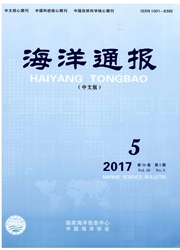

 中文摘要:
中文摘要:
根据2002-2003年珠江口12个航次的调查资料,分析探讨了不同调查时间和区域浮游幼虫的组成类型、丰度变化和环境因子的影响。以表层盐度(S)变化将调查海域划分成三个区域:Ⅰ区(S〈25)、Ⅱ区(25〈S〈30)和Ⅲ区(S〉30)。12个航次的调查结果显示:调查海域共出现浮游幼虫12个类型,隶属5个动物门,Ⅱ区和Ⅲ区的类型数一般高于Ⅰ区,软体动物门和棘皮动物门的幼虫只出现在Ⅱ区和Ⅲ区。其中2002年7月(夏季)、2003年1月(冬季)和4月(春季)的3个大航次结果表明珠江口浮游幼虫的平均丰度为61ind/m^3,三个区域的平均丰度比较为Ⅱ区(124ind/m^3)〉Ⅰ区(33ind/m^3)〉Ⅲ区(27ind/m^3),春夏季的丰度高于冬季。另外在Ⅰ区进行了9个小航次调查的研究表明:Ⅰ区浮游幼虫平均丰度较高,月份之间的丰度差别明显,不同站位之间也有差别。温度和食料是影响珠江口浮游幼虫丰度变化的主要因素。
 英文摘要:
英文摘要:
Based on the data obtained from 12 cruises in the Pearl River estuary from 2002 to 2003, species composition and abundance variations of planktonic larvae were reported and environmental influences on planktonic larvae were discussed. The Pearl River estuary can be divided into three regions according to its surface salinity, region Ⅰ ( salinity 〈 25 ), region Ⅱ ( salinity ranges from 25 to 30 ) and region Ⅲ( salinity 〉 30 ). Results showed that total 12 groups of planktonic larvae occurred in the Pearl River estuary, belonging to five phyla. Larval richness in regions Ⅱ and Ⅲ were higher than that in region Ⅰ. The result from 3 large cruises ( July 2002, January and April 2003 ) suggested that the average abundance of planktonic larvae in the Pearl River estuary was 61 ind/m^3. The average abundances were 124, 33 and 27 ind/m^3 in region Ⅱ, Ⅲ and Ⅰ, respectively, and the average abundance was higher in spring and summer than that in winter. Another result from 9 small cruises investigated in region Ⅰ only showed that planktonic larva abundance was high, probably because most of the investigation time was from April to October, and its comfortable environment stimulates abundance increasing. Temperature and food concentration play an important role in the abundance variation of planktonic larvae.
 同期刊论文项目
同期刊论文项目
 同项目期刊论文
同项目期刊论文
 Harmful algal blooms (HABs) in Daya Bay, China: An in situ study of primary production and environme
Harmful algal blooms (HABs) in Daya Bay, China: An in situ study of primary production and environme Occurrence of brackish water phytoplankton species at a closed coral reef in Nansha Islands, South C
Occurrence of brackish water phytoplankton species at a closed coral reef in Nansha Islands, South C Monsoon-forced distribution and assemblages of appendicularians in the northwestern coastal waters o
Monsoon-forced distribution and assemblages of appendicularians in the northwestern coastal waters o Two functionally distinct ciliates dwelling in acropora corals in the south china sea near sanya, ha
Two functionally distinct ciliates dwelling in acropora corals in the south china sea near sanya, ha 期刊信息
期刊信息
